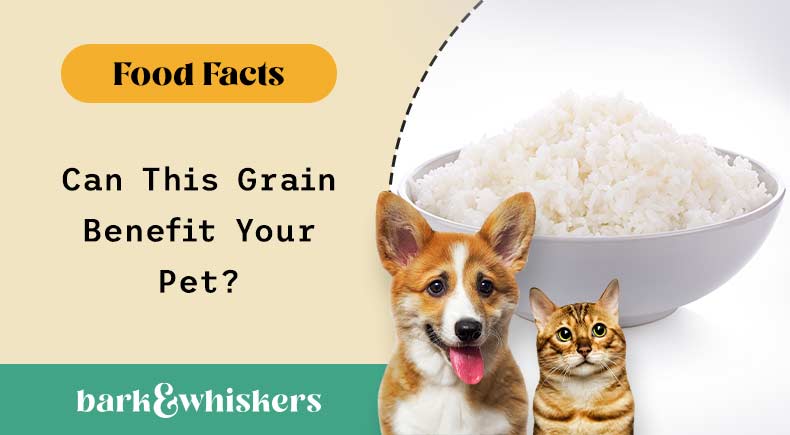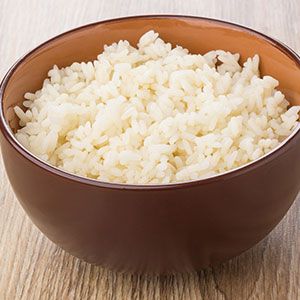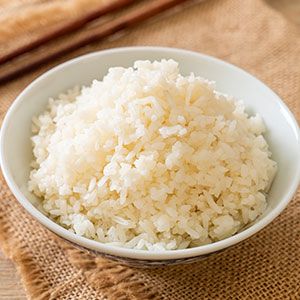White Rice: Can This Grain Benefit Your Pet?
Fluffy, starchy and compliments many dishes, this grain is a staple in many cuisines. Does it deserve a spot in your pet’s meals, too? Read this article to find out.

STORY AT-A-GLANCE
- White rice has undergone milling and polishing to remove the bran and germ from the grains, which whitens their color, prolongs shelf life and makes them easier to digest. However, this extensive process also strips down the naturally occurring vitamins, minerals, fiber and phytochemicals
- White rice is safe for pets to consume as it does not cause any toxic effects. However, it’s still a starchy food with a glycemic index of 66, meaning it provides excessive carbohydrates that are not essential to the diet of dogs and cats
- Should you decide to feed white rice to your pet, you can use it as a part of a nutritionally balanced homemade meal or as an ingredient in a DIY treat
- An important caveat about white rice is that it can contain arsenic as well as a few antinutrients, including phytic acid and lectin, albeit at lower amounts than other grains and legumes. Soaking the rice and washing thoroughly until the water is clear before cooking may help reduce these compounds
Editor's Note: This article is a reprint. It was originally published December 28, 2022.
Rice (Oryza sativa) is one of the oldest, most important grains in the world. There are thousands of rice varieties, which can be broadly categorized into two different types depending on how they’re processed: brown rice and white rice. White rice is more popular because it’s fluffier, more palatable and cooks more quickly than brown rice.1
White rice is a staple food in many countries around the world. It generally tastes bland, which serves as a blank canvas to compliment many main dishes. But the question is, can you also share it with pets? Continue reading to find out and learn more about white rice, the role it plays in processed pet food and how you can offer it to your pet.
Top White Rice Producers

China leads the world’s rice production, followed by India, Indonesia and Bangladesh. In the U.S., there are four regions that account for the country’s entire rice crop: Arkansas Grand Prairie, Mississippi Delta, Gulf Coast and Sacramento Valley of California.2

What Is White Rice?
White rice comes from the same crop as brown rice. But while brown rice still has the bran, germ and endosperm intact (hence why it’s considered whole grain), white rice has undergone milling and polishing to remove the bran and germ layers, which changes its color to white, prolongs its shelf life and makes it easier to digest.3
However, this extensive process also strips down the naturally occurring vitamins, minerals, fiber and phytochemicals that are found in the germ and bran. To replace at least a fraction of the lost nutrients, manufacturers often artificially enrich the fully milled and polished white rice with B vitamins and iron by spraying them onto the surface of the grains.4
Should You Give White Rice to Your Pet?
White rice is safe for pets to consume as it does not cause any toxic effects. However, it’s still a starchy food with a glycemic index of 66.5 It provides excessive carbohydrates that are not essential to the diets of dogs and cats, as they have no biological need for carbs for optimal health. Since starch is converted into sugar in your pet’s body, feeding a high-starch diet can increase blood sugar levels and increase the risk of inflammation, diabetes, obesity and other degenerative diseases.
For this reason, I do not recommend feeding starch to pets “just because.” If you must add carbs for medical reasons or to make homemade meals more affordable, remember that most active dogs can tolerate up to 20% starch in their diet without experiencing significant metabolic consequences, so try to limit their carb intake to that amount.
Should you decide to feed white rice to your pet, you can use it as part of a nutritionally balanced homemade meal or as an ingredient in a homemade treat. When offering healthy treats, keep in mind that all snacks, including treats that have white rice, should make up less than 10% of your pet’s daily caloric intake.
“If your goal is to optimize your healthy pet’s metabolic well-being and longevity, then the less carbs from starchy foods like white rice that you include in their diet the better.”
Prioritize calories that resonate with your pet’s innate metabolic machinery — make sure the bulk of dietary calories come from lean meats and healthy fats. If you need to add carbs to their diet, choose low-glycemic, fiber-rich carbs like sprouted rolled oats.
Phenolic Acids in White Rice
Although white rice contains less nutrients than other types of pigmented rice, it can still offer some beneficial bioactive compounds to your pet. According to the Journal of Cereal Science, phenolic acids account for 41% of the total acids in white rice. These include ferulic, isoferulic and syringic acids.6 A study published in Frontiers in Veterinary Science states:7
“Both ferulic acid and IFA [isoferulic acid] have been reported to have anti-inflammatory, anti-viral, anti-oxidative, and anti-diabetic properties and are commonly used as ingredients in herbal medicines in Japan and China.”
As for syringic acid, a study published in the European Journal of Pharmacology found that it exhibits cardioprotective action by inhibiting lipid peroxidation and improving antioxidant systems.8 Another study published in Comparative Clinical Pathology also showed that it helped attenuate oxidative stress in nephrotoxic rats.9
Should You Use White Rice for GI Issues?

A bland diet of ground beef and rice is still recommended for pets with gastrointestinal (GI) issues by some vets. However, feeding a pro-inflammatory food like rice to address GI upset is counterintuitive, especially since rice can ferment in your pet’s GI tract and feed pathogenic bacteria.
Canned or fresh steamed 100% pumpkin is a better alternative, as it has more soluble fiber than white rice, and is a better choice for pets with diabetes. It’s also ideal to use it in combination with ground turkey instead of beef, as turkey is lower in fat, if your pet is recovering from pancreatitis.
Antinutrients and Arsenic in White Rice
An important caveat about white rice is that it can contain arsenic and a few antinutrients, including phytic acid and lectin, albeit at lower amounts than other grains and legumes.10,11 Antinutrients can interfere with the digestion of nutrients in the gut,12 while arsenic is a toxic trace element that accumulates more in rice than other food crops.13
Should you decide to serve white rice to your family, including furry family members, you can reduce its arsenic and antinutrient content by soaking the rice and washing thoroughly until the water is clear before cooking; this also helps remove the excess starch and dust from the grains. Using a ratio of 6 cups water to 1 cup rice for cooking and then draining the excess water once the grains are tender has been found to help reduce arsenic content by up to 57%.14
Is White Rice Sustainably Produced?

Rice is one of the major food crops worldwide, feeding half of the world’s population, so it’s no surprise that it has a big impact on the environment. According to Food Print, the two main environmental impacts of rice are methane emissions and water use.15
Fortunately, there are now farms attempting to grow rice organically and using sustainable farming methods such as eliminating the use of pesticides, reducing tillage, planting rice varieties that emit less methane and decreasing the amount of times rice paddies are flooded to reduce methane emissions.16
More Tips on Preparing and Offering White Rice to Pets
When cooking white rice for your pet, avoid mixing in salt, seasoning or spices. Because rice is high in starch, it’s important to feed it only in small amounts to animal companions, as part of nutritionally balanced homemade meals to manage a medical condition where carbs are needed. In many cases, organic steel cut oats are a better choice, if a grain is required.
As much as possible, choose organic white rice. Not only will this reduce your family’s exposure to harmful chemicals, but it also gives you peace of mind knowing you’re eating food that’s sustainably grown.
The Role of White Rice in Pet Food
When you look at the ingredient list of pet foods, rice is often included on the label, along with other sources of starch, including corn, potatoes, quinoa, peas, lentils, wheat and barley, to name a few. According to PetFoodIndustry.com, “White rice is listed in 4% of dry dog and 3% of dry cat recipes, but less than 1% of wet recipes.”17 This is because the process of making extruded dry food requires a source of starch (sugar) to make the kibble stick together.
Pet food companies market grains and legumes as a rich source of “energy” (aka calories), but the truth is that these carbs are used because they’re much cheaper than meat of any quality. Unfortunately, when you consistently feed your dog or cat a high-starch diet that lacks the meat-based nutrients needed for optimal health (such as taurine), it can lead to nutritional deficiencies that predispose your pet to health problems over time. A carb-heavy diet also increases their risk of insulin resistance, which can set the stage for systemic inflammation and chronic metabolic issues.
This is why it’s important to limit carbs as much as you can, ideally using only low-glycemic, nutrient-dense roughage (veggies) as the “good carbs” in your pet’s diet. The most nutritious food you can feed your healthy dog or cat to help them thrive is a species-appropriate, minimally processed, fresh, whole food diet that’s low-starch and grain-free.
If You Must Feed Rice-Based Pet Food, Do This Carb Equation
If you must feed rice-based dry pet food for economic reasons, I recommend that you calculate the amount of carbs in the brands you are thinking about feeding to make sure your animal companion is receiving the amount of meat-derived protein they need. You should also rotate through the brands with the lowest amount of carbohydrates for some nutritional diversity.
On most pet food labels, the carb content is not listed. To calculate it, find the Guaranteed Analysis on the side of the dry pet food bag, where the amount of protein, moisture, fat and ash in the food are listed, then do this simple math equation:
Example, cat food: Royal Canin Indoor Adult Dry Cat Food18
Example, dog food: Royal Canin Medium Adult Dry Dog Food19
Again, your goal should be to keep all carbs to less than 20% of your pet’s diet, unless they need more carbs and less protein to manage a health condition. If you do decide to offer white rice to your pet, give organic, soaked rice to them sparingly and in moderation.
Sources and References
- 1 Harvard School of Public Health, Rice
- 2 ERS, Rice Sector at a Glance
- 3 Cleveland Clinic, June 11, 2021
- 4 Harvard School of Public Health, Rice
- 5 Oregon State University, Glycemic Index and Glycemic Load
- 6 Journal of Cereal Science. Volume 59, Issue 2, March 2014, Pages 211-218
- 7 Front Vet Sci. 2021; 8: 685606
- 8 European Journal of Pharmacology. Volume 849, 15 April 2019, Pages 135-145
- 9 Comparative Clinical Pathology volume 21, pages1559–1564 (2012)
- 10 Lectin Food Base, Is Rice High Or Low In Lectins?
- 11 Foods. 2021 Jan; 10(1): 23
- 12 Harvard School of Public Health, Are Anti-Nutrients Harmful?
- 13 Environ Sci Technol. 2007 Oct 1;41(19):6854-9
- 14 Food Chem Toxicol. 2006 Nov;44(11):1823-9
- 15,16 FoodPrint, October 1, 2021
- 17 PetFoodIndustry.com, January 8, 2018
- 18 Royal Canin, Indoor Adult Dry Cat Food
- 19 Royal Canin, Indoor Medium Adult Dry Dog Food











